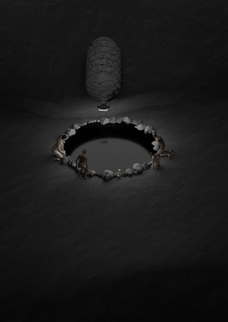Conceptual Textile and Mixed-Media Artist
Supposing Truth is a Woman (2019)
I wanted to believe.
So, I created the wounds and stuck my fingers in them.
Now, I have something to believe in.
Supposing Truth is a Woman is a spiritual reclamation project. It engages in mythogenesis to call attention to gendered and anthropocentric hierarchies established in Abrahamic and classical origin stories. It presents an alternative origin story and spiritual tradition that grows out of seeds that fall from the fruit of the Tree of Knowledge. I am the protagonist in this origin story, allowing me to take ownership of a belief system, rather than accepting traditions without questioning.
Origins (2018)
Origins I
Origins II
In the beginning, humans created the gods. They populated the earth with spirits, demons, angels, saints, nymphs, satyrs, ghosts, and devils. These immortals lived in turmoil and confusion.
The humans saw the turmoil and said, “Let there be order.”
Out of the chaos, structure arose. The immortals separated and segregated themselves. Some deities formed groups. The humans called these “Polytheistic.” Others formed pairs. The humans called this “Ditheistic.” Other deities isolated themselves. The humans called this “Monotheistic.”
The immortals wandered the earth spreading miracles, magic, and mayhem. Their omnipresence interfered with the humans’ daily lives, so the mortals said, “We must confine them.” And so it was. They built structures for the immortals and called them “churches,” “shrines,” “temples,” “synagogues,” “mosques” and “monasteries.”
Then the humans realized that they had put their time and effort into building the structures, but that they were not the ones using them. So, they developed activities for humans to perform in the spaces. They called these activities “rituals” and “worship.”
Humans saw that the rituals enforced structure in their lives, and the structure was good. So, they said, “Let us have codes and laws.” They created laws, doctrines, sins, and commandments. They called actions that were allowed by the laws “good” and actions that were disallowed “evil.” They called the understanding of what was good and what was evil “morality.”
The humans saw that their system for managing the gods was getting too complicated for them to manage collectively, so they selected specific humans to direct their relationships with the immortals. They called these humans “priests” and “priestesses.”
Then the humans saw that what they had created was good and wanted to advertise it, so they designated certain humans to profess their religion. They called these people “evangelists,” and “missionaries.”
Thus the immortals were organized in a way that allowed the humans to live without doubt for millennia. But with time and advancements, the humans grew skeptical of their way of organizing the immortals.
A new cult formed amongst the humans. It came to the others and said, “We can provide the structure you once created for the immortals. Let us give you new rituals and morals. Let us show you your best life.” The cult played a video of healthy women with glistening hair driving glittering cars to meet beautiful friends. They showed images of neon shrines along roadways that would call humans from all over the world to the rituals. They showed happy families gathered around Sold signs in front of picturesque and well-insured homes.
The humans saw that it was good. They discarded their antediluvian structures and surrendered control. They called the new system, “Religion.”
Comfort God (2017)
This stuffed doll embodies my childhood visualization of a male, white, glittering, bearded God who was comforting and always present. This characterization of God looks silly next to my unfolded laundry or sitting in my car. This performative piece highlights the disconnect between my adult life and the religion I internalized as a child through thirteen formative years of Catholic school in conservative Nebraska. By physically carrying around this version of God, I was forced to acknowledge the nostalgia of some of my ideas about religion and spirituality and question how I want the deeply-rooted relics of these childhood beliefs to exist in my adult life.
Ritualized / Habitualized (2017)
This series of six silkscreened and lasercut acrylic windows explores the process by which rituals become habits and habits become rituals. The center of each window depicts a routine that takes place at a certain time of day and that has taken on significance through repetition. Like a secular Liturgy of Hours, these windows mark time and sanctify everyday experiences, rather than grand narratives.





















